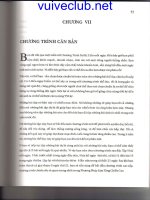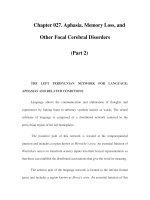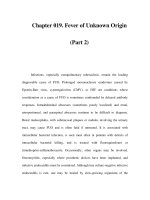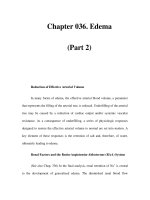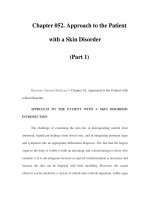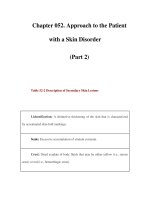Chapter 115. Approach to the Acutely Ill Infected Febrile Patient (Part 2) pptx
Bạn đang xem bản rút gọn của tài liệu. Xem và tải ngay bản đầy đủ của tài liệu tại đây (68.89 KB, 13 trang )
Chapter 115. Approach to the Acutely
Ill Infected Febrile Patient
(Part 2)
The Acutely Ill Patient: Treatment
In the acutely ill patient, empirical antibiotic therapy is critical and should
be administered without undue delay. Increased prevalence of antibiotic resistance
in community-acquired bacteria must be considered when antibiotics are selected.
Table 115-1 lists first-line treatments for infections considered in this chapter. In
addition to the rapid initiation of antibiotic therapy, several of these infections
require urgent surgical attention. Neurosurgical evaluation for subdural empyema
or spinal epidural abscess, otolaryngologic surgery for possible mucormycosis,
and cardiothoracic surgery for critically ill patients with acute endocarditis are as
important as antibiotic therapy. For infections such as necrotizing fasciitis and
clostridial myonecrosis, rapid surgical intervention supersedes other diagnostic or
therapeutic maneuvers.
Table 115-
1 Empirical Treatment for Common Infectious Disease
Emergencies
Clinical
Syndrome
Possible
Etiologies
Treatment Comme
nts
S
ee
Chap.
Sepsis without a Clear Focus
Septic
shock
Pseudom
onas
spp.,
gram
-
negative
Vancomycin
(1 g q12h) plus
Adjust
treatm
ent when
culture data
1
29, 130,
143,
or
Cefepime (2 g
q12h)
fludrocortisone
b
may improve
outcome in
patients with
septic shock.
Ceftriaxone (2
g q12h) plus
Overwhel
ming post-
splenectomy
sepsis
Streptoc
occus
pneumoniae
,
Haemophilus
influenzae,
Neisseria
meningitidis
Vancomycin
(1 g q12h)
If a β-
lactam–
sensitive strain
is identified,
vancom
ycin can
be discontinued.
2
65
Babesiosis
Babesia
microti
(U.S.),
Either: Atovaqu
one and
2
01, 204
or
Atovaquone
(750 mg q12h) plus
Azithromycin
(500-mg l
oading
dose, then 250 mg/d)
with fewer side
effects.
Treatmen
t with
doxycycline
(100 mg bid
c
)
for potential
coinfection with
Borrelia
burgdorferi
or
Ehrlichia
spp.
may be prudent.
Sepsis with Skin Findings
Penicillin (4
mU q4h)
or
Meningoco
ccemia
N.
meningitidis
Ceftriaxone (2
Consider
protein C
replacement in
fulminant
meningococcem
1
36, 167
g q12h) ia.
Rocky
Mountain spotted
fever (RMSF)
Rickettsi
a rickettsii
Doxycycline
(100 mg bid)
If both
meningococcem
ia and RMSF
are being
considered, use
chloramphenico
l alone (50–
75
mg/kg per day
in four divided
doses)
or ceftriaxone
(2 g q12h)
plus
doxycyclin
e (100 mg bid
c
)
If RMSF
is diagnosed,
do
xycycline is
the proven
superior agent.
Ceftriaxone (2
g q12h) plus
Purpura
fulminans
S.
pneumoniae
,
H.
influenzae,
N.
meningitidis
Vancomycin
(1 g q12h)
If a β-
lactam–
sensitive strain
is identified,
vancomycin can
be discontinued.
1
36, 265
Erythroder
ma: toxic shock
syndrome
Group A
Streptococcus,
Staphylococcus
Vancomycin
(1 g q12h) plus
If a
penicillin-
or
oxacillin
-
1
29, 130
toxigenic
bacteria should
be debrided; IV
immunoglobuli
n can be used in
severe cases.
d
Sepsis with Soft Tissue Findings
Necrotizin
g fasciitis
Group A
Streptococcus,
mixed
Penicillin (2
mU q4h) plus
Urgent
surgical
evaluation is
1
19, 130
substituted for
penicillin while
culture data are
pending.
Penicillin (2
mU q4h) plus
Clostridial
myonecrosis
Clostridi
um perfringens
Clindamycin
(600 mg q8h)
Urgent
surgical
evaluation is
critical.
1
35
Neurologic Infections
Bacterial
meningitis
S.
pneumoniae
,
N.
meningitidis
Ceftriaxone (2
g q12h) plus
If a β-
lactam–
sensitive strain
is identified,
vancomycin can
be discontinued.
If the patient is
>50 years old or
3
76
has comorbid
disease, add
ampicillin (2 g
q4h) for Listeria
coverage.
Vancomycin
(1 g q12h)
Dexamet
hasone (10 mg
q6h x 4 days)
improves
outcome in
adult patients
with meningitis
(especially
pneumococcal)
and cloudy
CSF, positive
CSF Gram's
stain, or a CSF
leukocyte count
>1000/µL.
Vancomycin
(1 g q12h) plus
Metronidazole
(500 mg q8h) plus
Brain
abscess,
suppurative
intracranial
infections
Streptoc
occus spp.,
Staphylococcus
spp., anaerobes,
gram-negative
bacilli
Ceftriaxone (2
g q12h)
Urgent
surgical
evaluation is
critical. If a
penicillin-
or
oxacillin-
sensitive strain
is isolated,
those agents are
superior to
vancomycin
(penicillin, 4
mU q4h; or
oxacillin, 2 g
q4h).
3
76
Quinine (650
mg tid) plus
Cerebral
malaria
Plasmod
ium falciparum
Tetracycline
Do not
use
glucocorticoids.
2
01, 203
(250 mg tid)
Spinal
epidural abscess
Vancomycin
(1 g q12h) plus
3
72
Staphylo
coccus
spp.,
gram-negative
bacilli
Ceftriaxone (2
g q24h)
Surgical
evaluation is
essential. If a
penicillin-
or
oxacillin-
sensitive strain
is isolated,
those agents are
superior to
vancomycin
(penicillin, 4
mU q4h; or
oxacillin, 2 g
q4h).
Focal Infections
Acute
bacterial
endocarditis
S.
aureus, β-
hemolytic
Ceftriaxone (2
g q12h) plus
Adjust
treatment when
culture data
1
18
endocarditis hemolytic
streptococci,
HACEK
group,
e
Neisseria
spp.,
S. pneumoniae
Vancomycin
(1 g q12h)
culture data
become
available.
Surgical
evaluation is
essential.
a
Drotrecogin alfa (activated)
is administered at a dose of 24 µg/kg per hour
for 96 h. It has been approved for use in patients with severe sepsis and a
high risk
of death as defined by an Acute Physiology and Chronic Health Evaluation II
(APACHE II) score of ≥25 and/or multiorgan failure.
b
Hydrocortisone (50-mg IV bolus q6h) with fludrocortisone (50-
µg tablet
daily for 7 days) may improve outcomes of seve
re sepsis, particularly in the
setting of relative adrenal insufficiency.
c
Tetracyclines can be antagonistic in action to β-
lactam agents. Adjust
treatment as soon as the diagnosis is confirmed.
d
The optimal dose of IV immunoglobulin has not been determin
ed, but the
median dose in observational studies is 2 g/kg (total dose administered over 1–
5
days).
e
Haemophilus aphrophilus, H. paraphrophilus, H. parainfluenzae
,
Actinobacillus actinomycetemcomitans
, Cardiobacterium hominis,
Eikenella
corrodens, and Kingella kingae.


